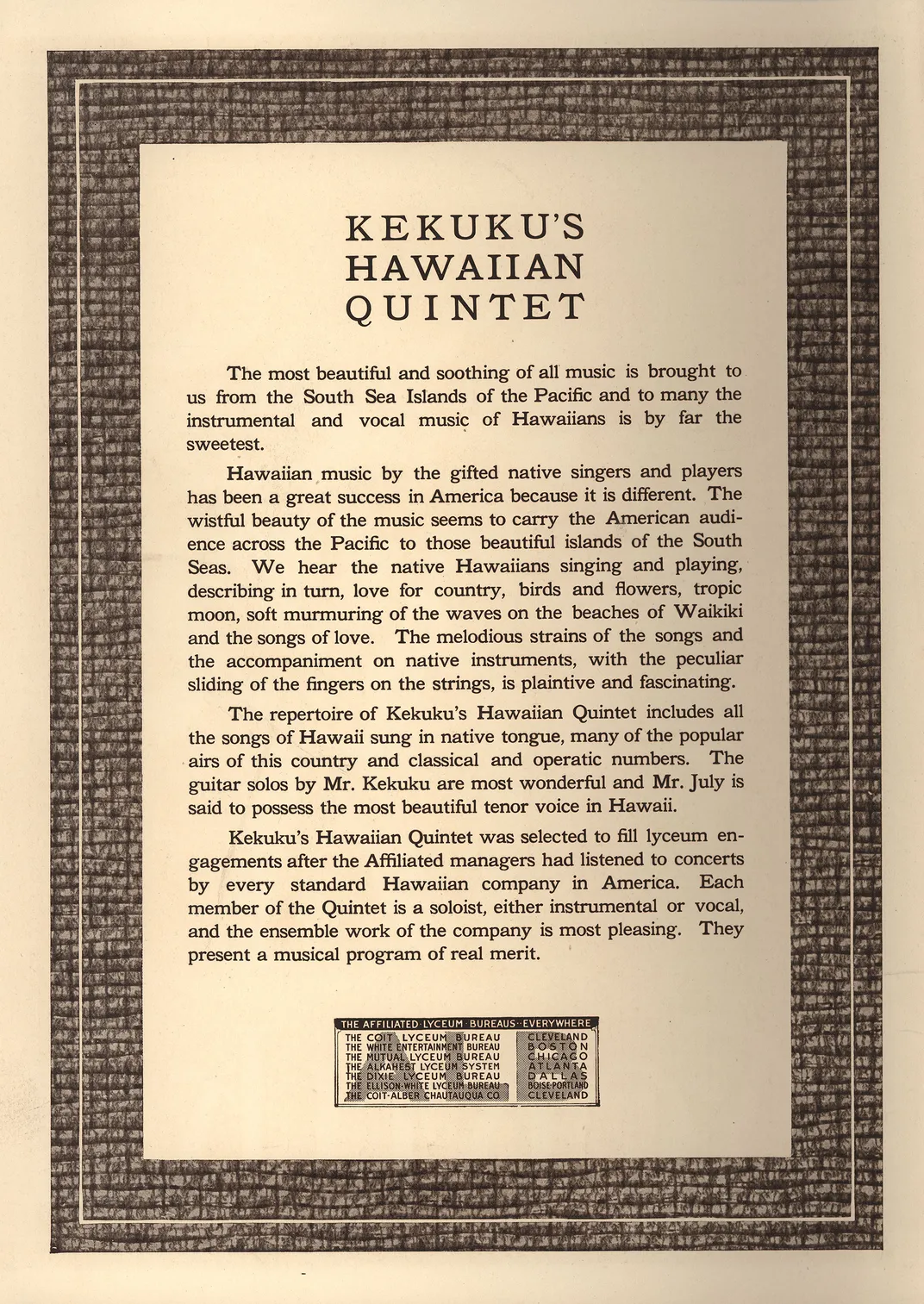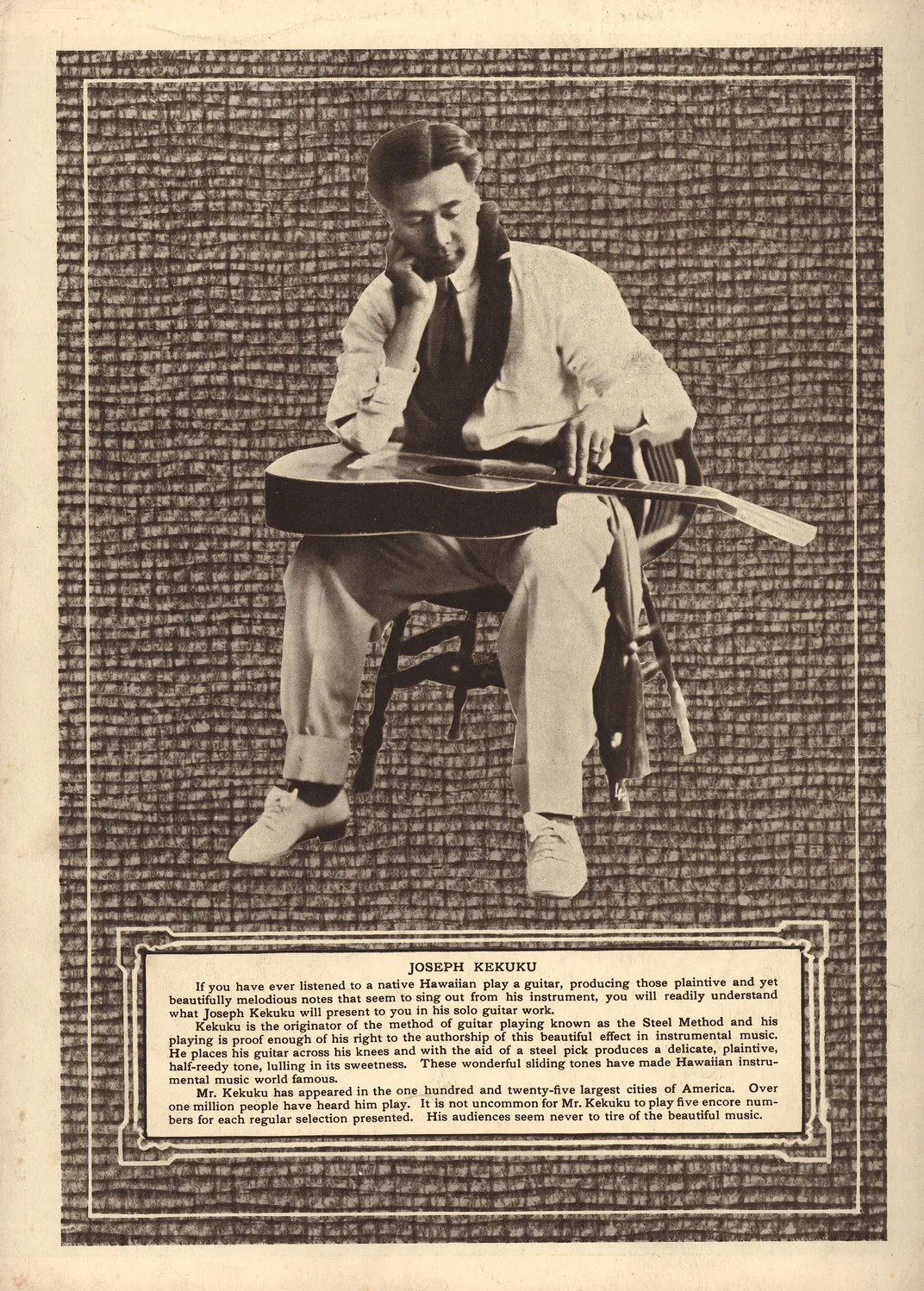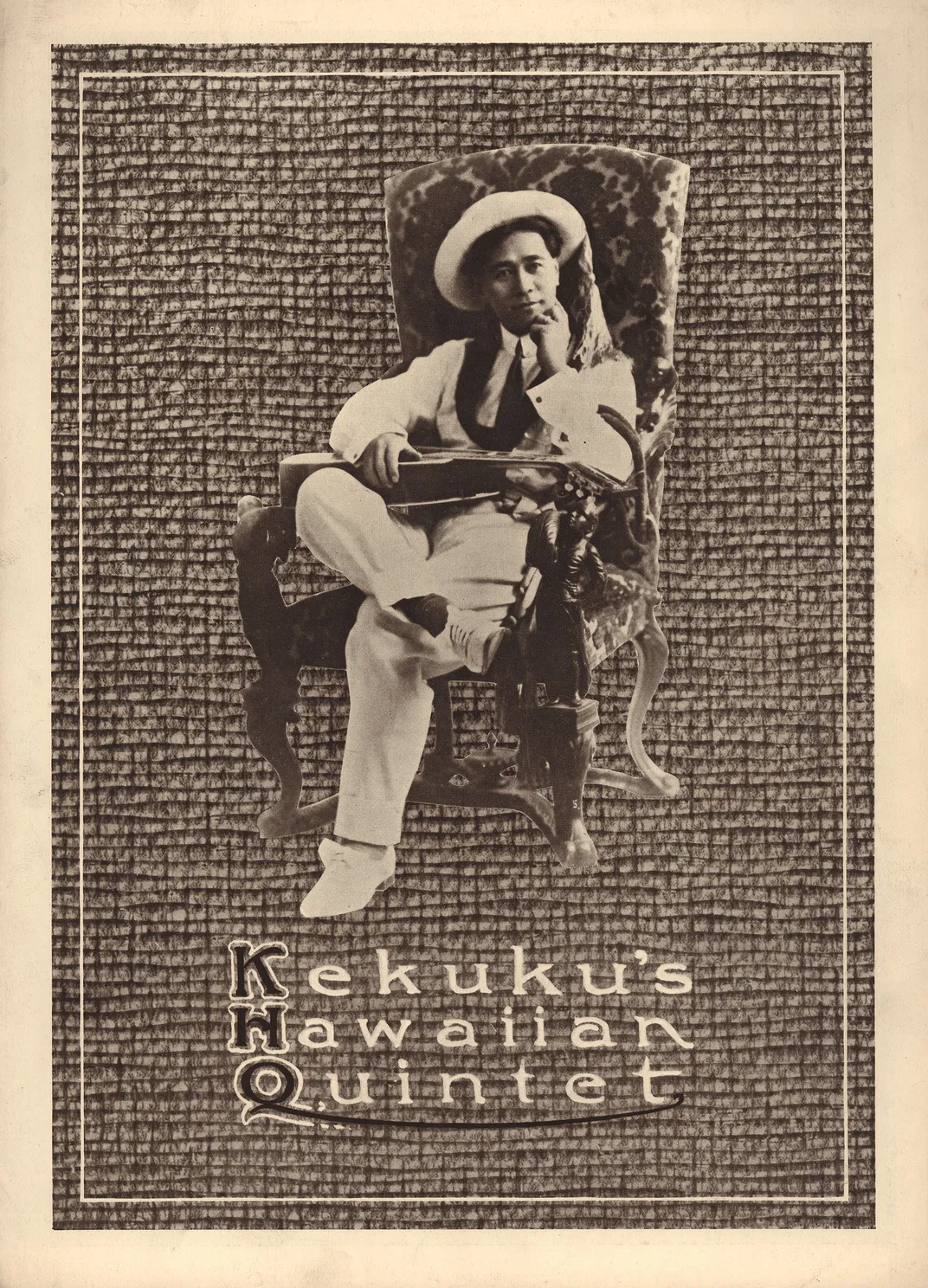How the Hawaiian Steel Guitar Changed American Music
The season finale of Sidedoor tells the story of an indigenous Hawaiian instrument with a familiar sound and unexpected influences
:focal(809x487:810x488)/https://tf-cmsv2-smithsonianmag-media.s3.amazonaws.com/filer/27/66/27665b46-fff7-487b-a760-54ab85a317b7/crop.jpg)
At the turn of the century, the lilting sound of the Hawaiian steel guitar captivated Americans fascinated with the tropical islands that were newly annexed by the U.S. As Hawaiian steel guitarists started touring the U.S. mainland and the ukelele and steel guitar were introduced to the public at expositions, Hawaiian steel guitar music grew wildly popular. In 1916, 78 rpm records featuring an indigenous Hawaiian instrument outsold every other genre of music in the United States.
To music historian and curator John Troutman of the Smithsonian’s National Museum of American History, the steel guitar, an instrument invented by a Hawaiian teenager named Joseph Kekuku, isn’t just notable for being wildly popular, but for how it influenced various genres of American music. After inventing the Hawaiian steel guitar in his high school dorm, Kekuku became a world-touring guitar soloist. The instrument is played on the lap, and the guitarist plucks the cords instead of strumming them while running a steel bar over the neck.
“His ingenuity resulted in the total kind of sonic transformation of the music that would become known as country, blues, and Rock ‘n’ Roll, and other genres as well,” says Troutman.
Before its soft, lilting sound became inseparable from music in the American South, the steel guitar captivated listeners in Hawaii, who were living through one of the most tumultuous chapters in the islands’ history.
The Hawaiian kingdom came into contact with westerners in the 18th-century when British explorer James Cook first sailed there. Cook’s arrival marked the beginning of North American and European interest in the Hawaiian islands as an ideal mid-Pacific stop for ships sailing between the U.S. and Asia. In the decades that followed, Hawai‘i would be radically transformed by colonization, missionaries and global trade.
In 1889, just a few years before Hawai‘i was annexed by the U.S., Kekuku was a high school student growing up in Lāʻie on the island of Oahu. According to Troutman, the town of Lāʻie became home to a Mormon community that was fleeing persecution on the U.S. mainland.
“Joseph Kekuku came from a community of native Hawaiians who were living among Mormon missionaries,” Troutman says, describing Lāʻie as a town with an enduring Hawaiian music tradition. “The Mormons sought refuge in Hawai‘i and one of the things that they had learned was that if they did not attempt to quash or suppress the traditions of the people that they were attempting to proselytize and convert to Mormonism, they would gain greater success.”
When Kekuku’s parents, who were devout Mormons, moved to Utah for a few years, the young musician stayed behind and enrolled in the Kamehameha School for Boys.
“He had been playing music for all of his life (including) some of the most popular modern Hawaiian songs of their day in the 1880s and early 1890s,” says Troutman. “And while Joseph was a student, he begins to develop a new technique for playing the guitar.”
That technique would lend itself to the steel guitar which has various creation myths, but all of them involve a young Kekuku and a stroke of genius. According to one of the most popular origin myths, Kekuku picked up a railway spike as he was walking along railroad tracks and put it in his pocket. When he returned to his dormitory later that day and was playing the guitar, he had a moment of inspiration—Kekuku pulled out the steel railroad tie, ran it along the guitar strings as he strummed, and noticed the unique sound the steel made.
While the exact details of Kekuku’s invention process are lost to history, the final product he created is not. As a student, Kekuku modified a guitar to raise the strings higher off the fretboard and created a smooth metal cylinder to run over it as he played.
Troutman, who wrote a book called Kika Kila: How the Hawaiian Steel Guitar Changed the Sound of Modern Music, says that while people have run objects over stringed instruments around the world for centuries, Kekuku created a musical technology that was refined, replicable and popularized.
“It's not simply running an object up and down a string,” he says. “It's actually creating music with it, adapting it to play existing music at the time, and enabling it to play music that had never been conceived before.”
After Kekuku’s classmates caught on to his new style of playing, musicians all around Honolulu adopted his technique. The guitar, which scholars say made its way via the Europeans onto Hawai‘i’s shores, had not only taken hold on the islands but was modified enough to become an indigenous Hawaiian instrument—the steel guitar.
On January 17, 1893, one of the most dramatic events in Hawaiian history took place—a militia of mostly American men demanded that Queen Lili‘uokalani step down as monarch. The ouster followed decades of colonization of the islands and efforts to concentrate more wealth and power into the hands of wealthy American businessmen.
“The overthrow of the queen is unexpected, horrific and traumatic in 1893,” Troutman says. “Hawaiian people spend the next few years strategizing on how to reverse the conditions and to restore the kingdom.”
But foreigners who were covertly lobbying for Hawai‘i’s annexation made efforts to prevent that from happening. As native Hawaiian power was curtailed, key parts of Hawaiian culture were also banned—the Hawaiian language, surfing, hula—all with varying degrees of success. Amid the political turmoil, many natives resisted the changes by holding onto their culture. Queen Lili‘uokalani herself was a prolific composer of Hawaiian songs, which were later performed for large audiences.
As Hawai‘i saw a regime change at the turn of the 20th century, native Hawaiians began fleeing the islands. A number of the people in this diaspora were singers, dancers and musicians.
“They knew that by traveling they could continue to perform their traditions that were being prohibited in the islands,” Troutman says, adding that many Hawaiians were fearful of what their fates would be under an American government. “Many of them interestingly had actually heard stories about Native Americans and how they were being incarcerated on reservations at the time. And they absolutely saw the potential connection of how they'd be treated as indigenous people of the United States politic.”
In 1904, Kekuku left the islands and traveled up and down the American West Coast, where he found a receptive audience. After he settled in Seattle, a newspaper called him “the world’s greatest guitar soloist.”
Kekuku not only played in venues nationally (and later internationally) but even offered steel guitar lessons. A Broadway play set in Hawai‘i called The Bird of Paradise toured the country for nine years. In 1915, the San Francisco World’s Fair opened, drawing 19 million people, and featuring the popular “Hawai‘i Pavilion,” where visitors could hear the steel guitar, and where the islands’ government could attract tourists.
The steel guitar’s impact went beyond the Pacific and the West coast—Hawaiian musicians drew crowds as they traveled the country, including the segregated South. Native Hawaiians barred from staying at whites-only hotels found lodging in boarding homes with African-American, native and immigrant performers, and it was in these spaces where Hawaiian musical traditions crossed paths with others.
“After their performances, they would all end up in boarding homes,” Troutman says. “This included mariachis, Chinese acrobats and all of these other performers, hanging out, playing music and having really good times together. They were kind of making the most of those conditions and learning from each other.”
For Troutman, Hawaiian performers are the unsung heroes of Southern music, especially country and blues, which is a surprising idea given that native Hawaiian influence is rarely cited in Southern music history.
“I grew up in Alabama and I think that a lot of people who think about Southern music typically imagine a very black and white world. Country music being the kind of white hillbilly music, and blues being the music of African-Americans in Mississippi, Alabama and Louisiana,” he says. “In large part that's due to the fact that the music industry itself began categorizing music along racial lines in the 1920s.”
Music executives marketed country music to whites and branded blues as African-American “race music.” The two categories conveniently fit into a segregated society, and later music scholars historicized the genres similarly, too.
But a deeper look into the region’s music, and the lines aren’t so clear. Jimmie Rodgers, who the Country Music Hall of Fame calls “the man who started it all” was known for blending various musical influences. As someone who worked on railroads from a young age, scholars say that Rodgers was exposed to African-American work songs, American roots music and the blues. According to musicologist Mary Davis, who edited a book on the life of Jimmie Rodgers, the country musician played with several native Hawaiian steel guitarists, including one named Joseph Kaipo for a song called “Everybody Does it in Hawaii” but their names aren’t mentioned in the liner notes.
Troutman argues that the Hawaiian influence is also erased from blues history, and cited the iconic blues slide guitar technique as an example.
Because a number of blues influences are traced back to West Africa, it has long been thought that the slide guitar technique evolved from the Diddley bow, a stringed instrument of West African origin. But Troutman believes that the slide technique came from Hawaiians, which he admits doesn’t sit well with a number of blues scholars.
Troutman supports his case noting that Delta blues singer and guitarist Son House, who is often considered the patriarch of the slide guitar blues style, cites Hawaiian influence in an interview with music researchers in the 1960s.
“They kept asking him, ‘so where was that first slide guitar that you heard?’ And he said, ‘Oh, you mean the Hawaiian way of playing?’ And then he tells the story of the people that started demonstrating to him the Hawaiian style of playing music.”
Other early blues stars like Robert Johnson and Blind Lemon Jefferson were known to hold the guitar flat in their lap and finger pick like Joseph Kekuku and other native Hawaiian steel guitarists did, too.
And as the steel guitar grew in popularity it made its way into the hands of later artists who would leave their mark on music in the 20th century through Rock ‘n’ Roll.
For Troutman, tracing the Hawaiian steel guitar’s origins not only gives credit to a group of musicians who are overlooked in American music history but also exposes the messy, intertwined musical history of the American South.
“When you really begin to dig into the music-making that was taking place in the South in the late 19th and early 20th-centuries, you hear influences that are all over the place,” he says. “And you also realize that there are people in many different communities in the South who are participating in that music-making.”
/https://tf-cmsv2-smithsonianmag-media.s3.amazonaws.com/accounts/headshot/Headshot_HaleemaShah.jpg)



/https://tf-cmsv2-smithsonianmag-media.s3.amazonaws.com/accounts/headshot/Headshot_HaleemaShah.jpg)